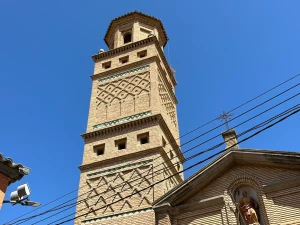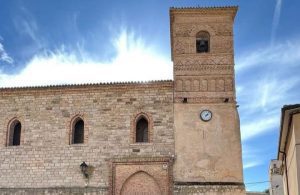
Circular from
the country school
The “Circular from the rural school” project is a cooperation project between rural development groups led by the Asociación Territorio Mudéjar.
The following have participated in the project: ADRI Calatayud-Aranda, ADRI Jiloca-Gallocanta, FEDIVALCA -Valdejalón and Campo de Cariñena-, ASOMO Tarazona and el Moncayo, CEDEMAR -Bajo Aragón Caspe and Ribera Baja del Ebro-, ADRAE -Ribera Alta del Ebro- and ADEFO Cinco Villas.
The objective is to develop educational materials around the Mudejar identity of the towns, placing rural schools and the educational community of the towns as the center of the project.
Based on the work developed, for almost three years, the students of fifteen schools have designed a walk through their town in which we can learn about the main points of interest and their connection with the Mudejar culture.

Torralba de Ribota
This walk shows us the work of the students of the school CRA Río Ribota in Torralba de Ribota.
Torralba de Ribota is located on a mound on the course of the river Ribota. It owes its name to the Torre Blanca (White Tower); its toponym derives from Turris Alba, Torre Alba or Torre Blanca, this being the first point on the route. During the walk, we will see other significant monuments in the town such as the Mudejar church of San Félix or the Mudejar square, where we can talk about reminiscences of the style.

1. History of the town
Torralba de Ribota owes its name to the Torre Blanca (White Tower), which was a defensive tower built in white stone during the War of the Two Peters (14th century). It must have been surrounded by a defensive system that included the whole town. It probably had a wall that was completed with this tower and the fortified church of San Félix.
This point is linked to the didactic activity 1

2. Mudejar architecture
The Mudejars made many types of buildings, depending on the function they were to have and the person who commissioned them. Fortress churches stand out, a typology of which we have numerous examples in our surroundings and which unites the religious function with the defensive function through its architecture. We would highlight the fortress churches of Tobed, Cervera de la Cañada and Torralba de Ribota.
This point is linked to learning activity 5.

3. Coexistence of cultures
After the arrival of the Christians in Zaragoza in 1119 and Calatayud in 1120, we can say that the Mudejar period began. The Christians allowed the Muslims, previous settlers, to remain in the territory, as they were necessary to sustain the local economy, and as they carried out work that was in great demand at the time, including crafts, agriculture and construction.
This point is linked to the didactic activity 2

4. Water and agriculture
The river that gives it its name flows through Torralba de Ribota, whose valley was populated by the Mudejar population during the Middle Ages. For the Islamic culture, water was a sacred asset. The abundance of water favoured the development of agricultural works and, therefore, the improvement and development of hydraulic engineering that can still be seen today.
This point is linked to the didactic activity 6

5. Reminiscences
Mudejar art came to an end in the 17th century when the Moors were expelled from the territory. However, we have preserved a style that has survived over the centuries. This is undoubtedly due to sharing a culture and territory for a long time. This is why we find materials, construction techniques and ornamental elements that remind us of Mudejar in later works. In this case, we find the Plaza Mudéjar, which is modelled on the material, i.e. brick, and the Mudejar decoration such as different ceramic motifs, being a work of the 21st century. This square is a place to meet and observe the marvellous views that surround Torralba de Ribota.
This point is linked to the didactic activity 7









